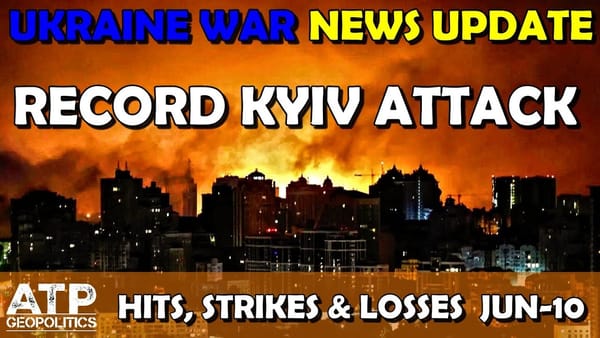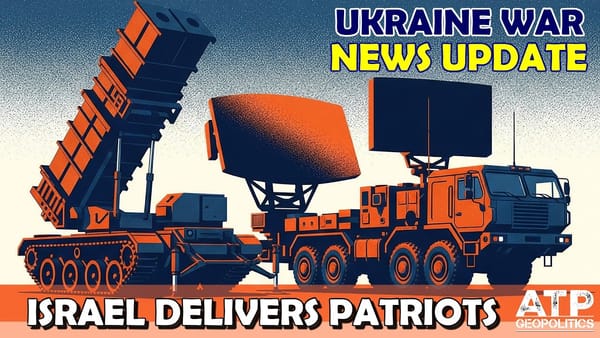Ukraine War Update NEWS: Military Aid News
Table of Contents 📖
"Why the hell do Russia get away with using Starlink? Why is Musk not being hauled over the coals about this? I don't get it. There's double standards going on here. Musk has too much power. And you know I'm not a fan of him, but this ain't helping."
Hello Team
🎦 00:00-00:22⏩
Jonathan welcomes viewers to the second part of the March 27th, 2024 Ukraine War News Update. He apologises for being slightly behind schedule and explains that due to the volume of information, this update will be split into two parts. This video will focus on Military Aid and Equipment.
Return to top⤴️
World Bank Approves $1.5 Billion Loan for Ukraine; Discussion on UK Aid
🎦 00:22-01:53⏩
The World Bank approves a $1.5 billion loan for Ukraine, with $984 million contributed by Japan and $516 million by the UK. Jonathan acknowledges previous criticisms regarding the UK's level of contribution relative to its GDP but highlights that the UK's limited military stockpiles pose a challenge. He emphasizes that the UK's assistance to Ukraine extends beyond military equipment, and these contributions might not always be publicly listed.
Return to top⤴️
Ukraine Requests Additional €5 Billion From Frozen Russian Assets in the EU
🎦 01:53-02:59⏩
Ukraine is requesting an additional €5 billion from frozen Russian assets held within the EU to bolster its war efforts. Jonathan explains that the EU proposes using 90% of the generated revenue from these assets to purchase weapons for Ukraine. However, there is a restriction limiting it to revenue accrued after February 15th, 2024. Euroclear, which currently holds €192 billion in Russian state assets, maintains a €5 billion buffer to address potential lawsuits. Ukraine contends that these funds should be allocated to cover expenses, risks, and losses directly caused by the war. Jonathan highlights the complexity of the situation, where Ukraine seeks access to these funds while Euroclear aims to mitigate potential legal ramifications.
Return to top⤴️
EU Grants €130 Million to Rheinmetall for Ammunition Production Expansion
🎦 02:59-03:27⏩
The EU has granted over €130 million to Rheinmetall, the German arms manufacturer, to expand its ammunition production capabilities. This initiative will involve Rheinmetall's European subsidiaries across Germany, Hungary, Romania, and Spain undertaking six different projects. Jonathan interprets this as a strategic move by the EU, signifying their commitment to strengthening defence production within its borders. He sees this as the EU transitioning to a 'war footing', aiming to enhance its security readiness in the face of the ongoing conflict.
Return to top⤴️
France Ready to Requisition Weapons Production to Aid Ukraine
🎦 03:27-05:42⏩
France, according to French Defence Minister Sébastien Le Cornu, is prepared to requisition industrial facilities and prioritize weapons production to expedite the delivery of essential arms and ammunition to Ukraine. Jonathan commends France for aligning its actions with the rhetoric of President Emmanuel Macron, demonstrating a tangible commitment to supporting Ukraine's war effort. He expresses admiration for France's proactive approach and hopes for its continuation. This shift, likened to a 'quasi-war footing', is deemed crucial not only for France's security but also for European and global security, ultimately aiding Ukraine's fight against Russia. Jonathan draws a parallel to the US Defense Production Act, where state intervention supersedes market forces during critical times to ensure national security priorities.
Return to top⤴️
France to Deliver 78 Caesar Howitzers and 80,000 Shells to Ukraine
🎦 05:42-06:10⏩
Jonathan reiterates previous reports about France's commitment to deliver 78 Caesar Howitzers along with 80,000 shells to Ukraine. He remains uncertain about the exact delivery timeline, suggesting a staggered approach rather than a single shipment. He invites viewers to share any information they might have regarding the timeframe.
Return to top⤴️
Slovenia Joins Czech Ammunition Initiative for Ukraine
🎦 06:10-07:12⏩
Slovenia has joined the Czech Republic in their initiative to provide ammunition to Ukraine. The Czech Foreign Minister, Jan Lipavský, has indicated that their initial pledge of 800,000 shells could potentially increase to 1.5 million. However, Jonathan acknowledges that while funding has been pledged, the actual transfer of funds and the subsequent manufacturing and delivery processes can be lengthy. Lipavský highlights the positive impact of this initiative, noting that the assurance of consistent ammunition supply has changed Ukraine's approach to utilising existing stockpiles.
Return to top⤴️
The Significance of Military Aid Pledges and Their Impact on Battlefield Tactics
🎦 07:12-08:48⏩
Jonathan emphasizes the psychological impact of pledged military aid on Ukrainian forces. Knowing that reinforcements and supplies are on the way enables better strategic planning and resource allocation. He cites the example of the recent USAID package and its impact on Ukrainian tactics. Assured future supplies have encouraged Ukrainian forces to utilize existing resources more confidently. Jonathan observes an increase in Ukrainian artillery usage, attributing it to the guaranteed ammunition supply from the Czech initiative. This assurance allows for strategic depletion of existing stockpiles, knowing that reinforcements are secured. He contrasts this with scenarios where unpredictable aid flows could lead to premature depletion of resources.
Return to top⤴️
Ukraine Produces Bogdanas: Self-Propelled Howitzers
🎦 08:48-09:16⏩
Jonathan highlights Ukraine's efforts in producing their own self-propelled howitzers, the Bogdanas. He describes them as visually similar to the French Caesar Howitzers. The production line's location is undisclosed, assumed to be somewhere in western Ukraine. He anticipates Russian attempts to locate and target this facility, recognizing its strategic importance. He notes that the Bogdanas are increasingly seen in training videos and are being deployed to the front lines.
Return to top⤴️
Ukrainian Troops Train on S-300s in Greece, Potential Transfer to Ukraine
🎦 09:16-10:36⏩
Jonathan shares information received from a source (Digital Forward Observer) about a group of approximately 50 Ukrainian troops returning from Athens to Warsaw after undergoing training on S-300 air defence systems in Suda, Crete. The S-300s, originally purchased by Cyprus but transferred to Greece after Turkish threats, are deemed critical for Ukraine's defence against Russian air attacks. Jonathan speculates that these S-300s, following the training, are likely to be transferred to Ukraine, potentially deployed near the frontlines to counter Russian airstrikes.
Return to top⤴️
Greece Considers Selling F-16s and Mirage Jets to Streamline its Air Force
🎦 10:36-11:34⏩
Jonathan discusses Greece's plans to rationalise its fighter jet fleet by selling off some of its F-16s and Mirage jets. This decision is driven by a need to simplify logistics and accommodate new acquisitions, likely F-35s from the US. He suggests that these older aircraft, if of the right specifications, could be valuable assets for Ukraine's air force.
Return to top⤴️
Saab to Build US Munitions Factory for GLSDB Kits; Discussion on US Patriot Systems
🎦 11:34-14:50⏩
Saab will establish a new munitions production facility in the United States to produce adapter kits for the Ground Launched Small Diameter Bomb (GLSDB). This system, developed in partnership with Boeing, converts existing rockets into guided missiles with an extended range of 150 kilometers, making them compatible with HIMARS and similar launchers. Jonathan likens this to the JDAM system used for converting unguided bombs into smart munitions, offering a cost-effective solution for long-range strikes. Jonathan then shifts focus to the US Patriot missile defence system. He clarifies conflicting figures regarding the number of systems in the US inventory, suggesting confusion between launchers and batteries. While acknowledging the US has a significant number of Patriots, he highlights their strategic deployment protecting critical assets, making it challenging to transfer them to Ukraine. Unlike Bradley fighting vehicles where the US has a surplus, Patriots represent a more critical and limited resource.
Return to top⤴️
Concerns About Russian Use of Starlink in Ukraine
🎦 14:50-18:35⏩
Jonathan expresses concern over reports of Russian forces utilizing Starlink terminals in Ukraine. Despite US sanctions restricting Russia's access, reports from CNN and observations from Ukrainian troops suggest increasing Russian reliance on Starlink, possibly acquired through third-party countries. He highlights key issues with Starlink in Ukraine: Ukrainian users report significantly reduced internet speeds and inconsistent connectivity, requiring frequent reboots. Jonathan questions whether these are deliberate limitations imposed by Starlink, potentially influenced by Russia, or simply technical issues. He also raises concerns about the ability to selectively disable individual Starlink terminals and the potential risks associated with identifying users. Jonathan criticises the lack of a stronger response from the US government, drawing a parallel to the hypothetical scenario of Russia using captured US military hardware. He questions why the use of Starlink by Russian forces to target Ukrainians and destroy US-supplied equipment isn't met with the same level of condemnation or sanctions. Jonathan expresses his disappointment with Elon Musk, stating that Musk's inaction in this matter is problematic.
Return to top⤴️
Black Market for Starlink Terminals and Potential US Response
🎦 18:35-19:00⏩
Jonathan highlights a Bloomberg report about a growing black market for Starlink terminals, with instances of their use being reported in conflict zones like Yemen and Sudan. He questions why the Biden administration hasn't taken more decisive action to tighten export controls, preventing Starlink terminals from falling into the wrong hands. He reiterates his stance that allowing Russia to utilise Starlink for military purposes is more problematic than them using a single captured Bradley fighting vehicle, given the potential strategic advantage Starlink provides.
Return to top⤴️
Rumours of North Korean Troop Deployment to Ukraine
🎦 19:00-19:45⏩
Jonathan discusses claims from a Russian military reporter, Sladkov, who alleges that North Korea has 50,000 special forces troops and 800,000 regular troops prepared to join the war on Russia's side. Jonathan expresses skepticism and concern for the welfare of these potential troops, comparing it to the disappearance of 10,000 Syrian volunteers a year prior. He notes that such pronouncements could be a tactic to shift the Overton Window, normalising the idea of North Korean involvement. This raises questions about potential impacts on international alliances, South Korea's position, and the overall trajectory of the conflict.
Return to top⤴️
Analysis of Russian Artillery Strength and Production Capacity
🎦 19:45-26:09⏩
Jonathan delves into an extensive analysis by Ben, a Twitter user, who has been assessing Russian artillery capabilities using satellite imagery. Ben's research suggests that Russia's initial artillery stockpile of 23,500 units, which included both towed artillery and self-propelled guns, has dwindled to 9,500. This indicates a potential loss of 14,000 artillery pieces, although Jonathan acknowledges that some might be out of action due to dismantling for parts rather than destruction. Of the remaining units, only 4,500 are estimated to be operational in Ukraine, highlighting a significant reduction in their active artillery force. This analysis suggests that Russia is increasingly reliant on towed artillery as self-propelled guns become depleted. Moreover, the reliance on cannibalized parts raises concerns about the declining quality and reliability of the remaining artillery pieces. Jonathan points to the lack of evidence for Russia's ability to manufacture new artillery, particularly towed artillery, due to closed production facilities. This inability to replenish losses, coupled with dwindling stockpiles and reliance on inferior replacements, raises questions about the long-term sustainability of Russia's artillery warfare capabilities. He concludes that the degradation of Russia's artillery strength, both in terms of numbers and quality, will likely impact their combat effectiveness in the long run.
Return to top⤴️
Wrap Up
🎦 26:09-26:14⏩
Jonathan concludes the video by stating that he will move on to discuss geopolitical developments in a separate video.
Return to top⤴️



